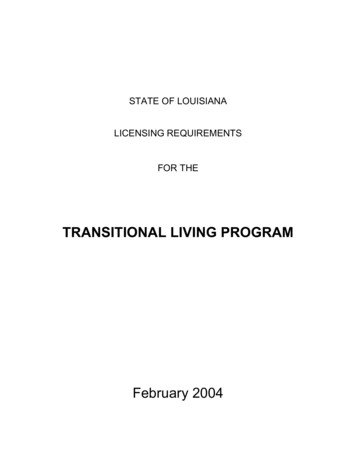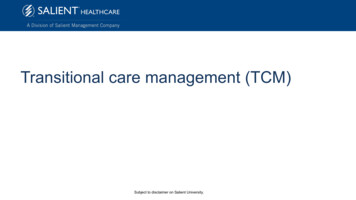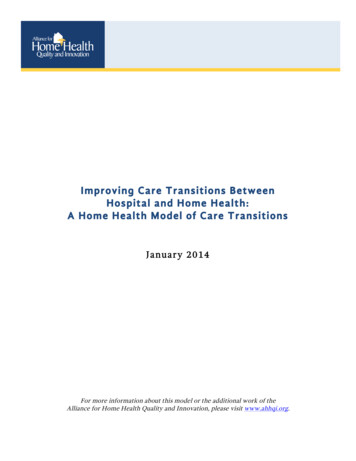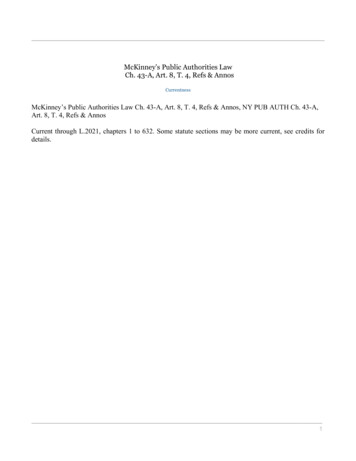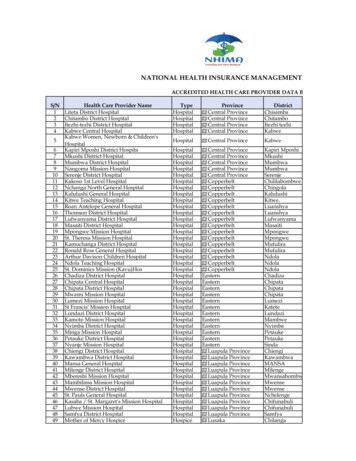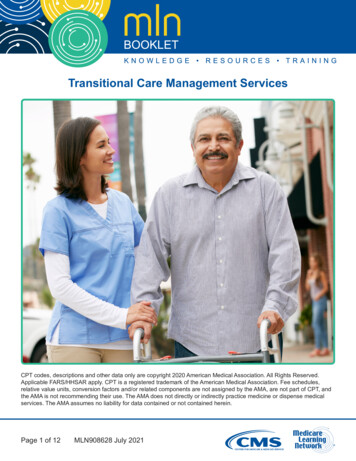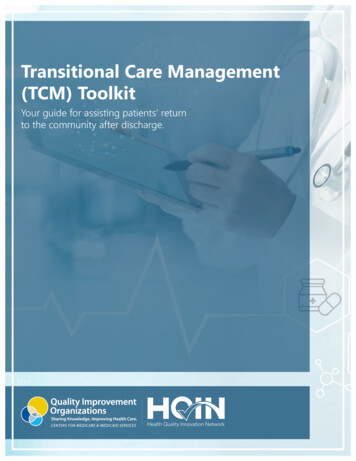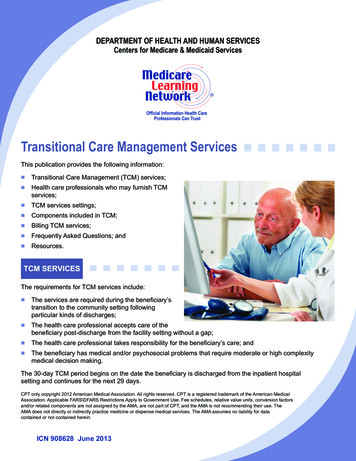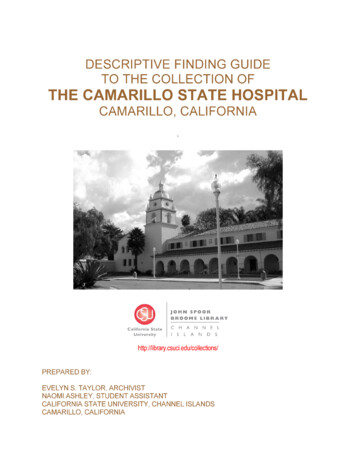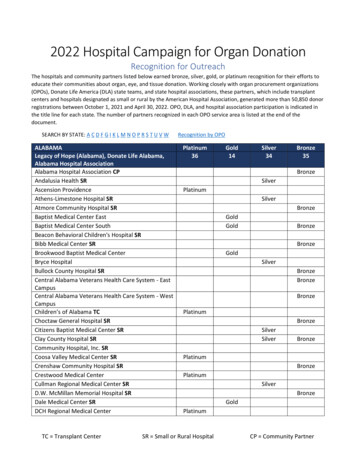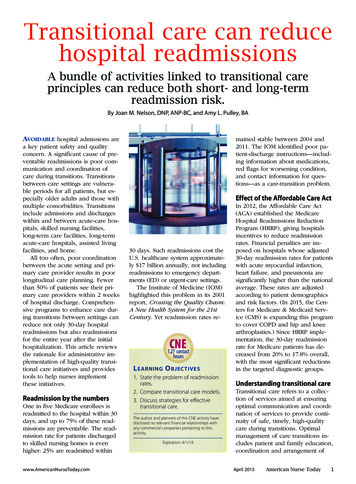
Transcription
Transitional care can reducehospital readmissionsA bundle of activities linked to transitional careprinciples can reduce both short- and long-termreadmission risk.By Joan M. Nelson, DNP, ANP-BC, and Amy L. Pulley, BAAVOIDABLE hospital admissions area key patient safety and qualityconcern. A significant cause of preventable readmissions is poor communication and coordination ofcare during transitions. Transitionsbetween care settings are vulnerable periods for all patients, but especially older adults and those withmultiple comorbidities. Transitionsinclude admissions and dischargeswithin and between acute-care hospitals, skilled nursing facilities,long-term care facilities, long-termacute-care hospitals, assisted livingfacilities, and home.All too often, poor coordinationbetween the acute setting and primary care provider results in poorlongitudinal care planning. Fewerthan 50% of patients see their primary care providers within 2 weeksof hospital discharge. Comprehensive programs to enhance care during transitions between settings canreduce not only 30-day hospitalreadmissions but also readmissionsfor the entire year after the initialhospitalization. This article reviewsthe rationale for administrative implementation of high-quality transitional care initiatives and providestools to help nurses implementthese initiatives.Readmission by the numbersOne in five Medicare enrollees isreadmitted to the hospital within 30days, and up to 75% of these readmissions are preventable. The readmission rate for patients dischargedto skilled nursing homes is evenhigher: 25% are readmitted withinwww.AmericanNurseToday.commained stable between 2004 and2011. The IOM identified poor patient-discharge instructions—including information about medications,red flags for worsening condition,and contact information for questions—as a care-transition problem.Effect of the Affordable Care Act30 days. Such readmissions cost theU.S. healthcare system approximately 17 billion annually, not includingreadmissions to emergency departments (ED) or urgent-care settings.The Institute of Medicine (IOM)highlighted this problem in its 2001report, Crossing the Quality Chasm:A New Health System for the 21stCentury. Yet readmission rates re-CNE1.27 contacthoursL EARNING O BJECTIVES1. State the problem of readmissionrates.2. Compare transitional care models.3. Discuss strategies for effectivetransitional care.The author and planners of this CNE activity havedisclosed no relevant financial relationships withany commercial companies pertaining to thisactivity.Expiration: 4/1/18In 2012, the Affordable Care Act(ACA) established the MedicareHospital Readmissions ReductionProgram (HRRP), giving hospitalsincentives to reduce readmissionrates. Financial penalties are imposed on hospitals whose adjusted30-day readmission rates for patientswith acute myocardial infarction,heart failure, and pneumonia aresignificantly higher than the nationalaverage. These rates are adjustedaccording to patient demographicsand risk factors. (In 2015, the Centers for Medicare & Medicaid Service (CMS) is expanding this programto cover COPD and hip and kneearthroplasties.) Since HRRP implementation, the 30-day readmissionrate for Medicare patients has decreased from 20% to 17.8% overall,with the most significant reductionsin the targeted diagnostic groups.Understanding transitional careTransitional care refers to a collection of services aimed at ensuringoptimal communication and coordination of services to provide continuity of safe, timely, high-qualitycare during transitions. Optimalmanagement of care transitions includes patient and family education,coordination and arrangement ofApril 2015American Nurse Today1
care in the post-acute care setting,and aiding communication amonghealthcare professionals involved inthe patient’s care transition.Several transitional-care programshave gone through randomizedcontrolled trials and been found tosignificantly lower readmissionrates, with reductions up to 45%.These programs incorporate suchservices as comprehensive dischargeplanning, post-discharge telephoneoutreach, home visits, patient-centered discharge instructions, followup with a primary care provider,and medication reconciliation.Specific care transition modelsTransitional care programs that reduce both healthcare costs andreadmissions include the care transitions intervention model (Colemanmodel), transitional care model(Naylor model), and Better Outcomes for Older Adults throughSafe Transitions (BOOST) model.Care transitions interventionmodelEric Coleman’s care transitions intervention model is a 4-week program designed to foster patient engagement and promote a smoothtransition from the hospital orskilled nursing facility to the home.It has been shown to decrease rehospitalizations. This model restson four pillars: medication self-management maintenance of a personal healthrecord primary care physician follow-up alertness to red flags.A transition coach focuses on thepatient’s self-identified goals andhelps the patient develop self-management skills. The relationship isrelatively short, spanning only the4-week intervention period, and thecoach doesn’t assume home-careor case-management responsibilities. Coaching starts in the hospital,where the coach describes the transitional care program, obtains thepatient’s consent to participate, and2American Nurse Todayintroduces the Coleman personalhealth record (www.caretransitions.org/documents/phr.pdf). Thisrecordguides the patient in documenting medication and other medical information and generates alist of questions for the healthcareprovider. A home visit is scheduledwithin 72 hours of discharge.During the home visit, the coachassists the patient with a pre-/posthospitalization medication reviewand addresses any discrepancies.The patient develops his or herown list of questions for the primary care provider. The coach andpatient review the discharge planand update the personal healthrecord. Finally, the coach discussessymptoms and drug side effects andestablishes an alert-and-responsesystem.After the home visit, three follow-up calls take place to addressthe patient’s remaining medicationquestions, discuss the outcomes offollow-up primary care providervisits, describe available supportservices, and assist with schedulingadditional follow-up appointmentsas needed.Transitional care modelMary Naylor’s transitional care modelinvolves a 1-to-3 month period ofinterventions with high-risk olderadults to prevent hospital readmission. An advanced practice registerednurse (APRN) performs a predischarge patient assessment, and thencollaborates with the hospital teamto develop a transitional care plan.The APRN makes multiple homevisits, uses telephone outreachthroughout the transitional care period, and promotes information transfer between the acute-care and primary-care settings by accompanyingthe patient to the first primary carefollow-up visit. Cornerstones of thismodel are patient engagement, goalsetting, and communication with patients, families, and healthcare teammembers. The APRN helps the patient identify early signs and symp-Volume 10, Number 4toms of a worsening condition toexpedite prompt intervention andavoid future hospitalization.Patients with specific risk factorsare good candidates for this caremodel. (See the box below.)Patients who can benefit from thetransitional care modelPatients with cognitive impairment orany two of the followingcharacteristics can benefit fromNaylor’s transitional care model: age 80 or older functional deficits active psychiatric condition four or more comorbidities six or more prescriptionmedications two or more hospitalizations in the6 months before the index period inadequate social support poor health literacy poor adherence to medicalrecommendations.Project BOOSTAn initiative of the Society of Hospital Medicine, Project BOOST wasdeveloped by a team of payers,regulators, and leaders in healthcare transitions and hospital medicine to improve the quality of caretransitions. This model focuses ondischarge processes and communication with patients and receivingproviders. It uses a systemic approach to enhance the quality oftransitions and gives clinicianstools to help them standardize,initiate, and improve hospital practices. Evidence-based tools areavailable in a toolkit available freeof charge to healthcare professionals with an interest in transitionalcare. Project BOOST also providestechnical support and education toproject management teams andhelps develop a community of organizations that freely share strategies and struggles with programimplementation.Project BOOST involves dischargeplanning, medication reconciliation,patient and family communication,and primary care provider communiwww.AmericanNurseToday.com
cation before discharge. It includespost-discharge telephone follow-up(including facilitating appointmentscheduling). Patient-centered discharge instructions actively involvethe patient in his or her own care.The BOOST Risk AssessmentTool, called the “8 P’s,” identifiesmodifiable risk factors that guidedischarge planning. (See the boxbelow.)“8 P’s” of the BOOST RiskAssessment ToolThis assessment tool targets patientrisk factors known to pose a risk forpost-discharge complications. The 8P’s are: Polypharmacy Psychological comorbidities Principal diagnosis of cancer, stroke,diabetes, chronic obstructivepulmonary disease, or heart failure Physical or functional limitations Poor health literacy Poor social support Prior hospitalization in the 6months before the index period Palliative care needs.Project BOOST aligns evidencebased interventions with specificproblems identified by the “8 P’s”tool. It maximizes patient involvement in the plan of care throughconcise patient-centered dischargeinstructions tailored to the patient’sliteracy level. The instructions include the reason for hospitalization, red flags signaling complications, follow-up appointments,post-discharge care, key contactinformation, and space for the patient to list questions for the primary care provider. Before discharge, nurses use the teach-backmethod to review this informationwith the patient.INTERACT programInteractions to Reduce Acute CareTransfers (INTERACT) is designed toimprove care in long-term care (LTC)and skilled nursing facilities (SNFs),with the goal of reducing preventable hospital readmissions. It inwww.AmericanNurseToday.comcludes multiple quality-improvementstrategies and tools to help healthcare professionals in LTC and SNFsidentify, document, and communicate early changes in the patient’scondition so interventions can beginbefore the condition becomes serious enough to warrant rehospitalization. INTERACT tools and strategies aid effective advance careplanning; communication betweenLTC, SNF, and hospital providers;and management of changes in thepatient’s condition.An evaluation of 25 LTC facilitiesthat incorporated INTERACT quality-improvement methods foundreadmission rates decreased anaverage of 17%. Facilities with agreater commitment and resourcesallocated to implementing the model saw greater reductions thanthose with a minimal commitment.Guidelines and key strategiesfor transitional careThe American College of Physicians, Society of General InternalMedicine, Society of Hospital Medicine, American Geriatrics Society,American College of EmergencyPhysicians, and Society of AcademicEmergency Medicine have workedtogether to develop consensus standards for transitional care. Practicestandards have been developedbased on this framework of guidingprinciples. Both the National Transitions of Care Coalition and the Institute for Healthcare Improvement’s State Action on AvoidableRehospitalizations specify standardsof care and provide transitionguides in these consensus standards. For a summary of all keyrecommendations from leadingtransitional care organizations, seeTransitional care principles.)Other recommendations forimproving care transitions havebeen developed by the NationalTransitions of Care Coalition(www.ntocc.org), Care TransitionsProgram (www.caretransitions.org),and Institute for Healthcare Im-provement’s State Action on Avoidable Hospitalizations ges/default.aspx.) Usingstandardized forms aids implementation of these recommendations.(See the box below.)Transitional Care ToolkitsTransitional care toolkits are availablefrom the organizations below.National Transitions of Care sionals.aspxThis website offers tools andinformation for healthcareprofessionals seeking to improvetransitional care.The Care Transitions .pdfThis website provides patientmaterials to help patients track theirimportant medical information andplan for hospital discharge.www.caretransitions.org/provider tools.aspThis page provides links to tools forhealthcare professionals using theCare Transitions Model.www.caretransitions.org/mdt main.aspThis page offers access to theMedication Discrepancy Tool used inthe Care Transitions Program.Society of Hospital Medicine: Project Boost n/Implementation Toolkits/ProjectBOOST/Web/Quality Innovation/Implementation Toolkit/Boost/BOOSTIntervention/BOOST Tools.aspxThis website provides access to the“8P’s” Risk Assessment and other toolsused in Project BOOST.Teach-Back Method Toolkitwww.teachbacktraining.org/This website offers the “Always UseTeach-back!” training toolkit.INTERACT: Interventions to Reduce Acute-CareTransfershttp://interact2.net/#This website provides trainingprograms for healthcare providersand registered nurses, as well as toolsto enhance recognition of a change inthe condition of residents of longterm care or skilled nursing facilities.April 2015American Nurse Today3
Transitional care principlesThis chart summarizes the principles and corresponding activities recommended by leading transitional care organizations.PrincipleActivitiesAccountability Patient receives post-acute care follow-up within 24 hours of discharge to monitor condition and reinforceand monitor transition plan. Patient has primary-care appointment within 1 week of acute-care episode. Sending provider is responsible for patient’s care until receiving provider has communicated that he or sheis assuming responsibility and acknowledges receipt and understanding of discharge information and planof care.Communication Two-way communication between providers, patients, and care team includes opportunities forclarification and feedback. Communication should include community provider, patient, and family in assessing post-discharge needs. Telephone follow-up should be provided shortly after dischargeTimely feedbackand flow ofinformation Use formal tools, such as Universal Discharge or Transition Checklist in patient-friendly language.Discharge information is developed with and provided to patient and family.Use electronic means to transfer health information expediently and securely, ideally, within 24 hours.Patient information arrives to receiving provider or agency ahead of patient.Patient and familyinvolvement in allsteps of transition Use formal transitional care tools, such as Coleman personal health record, to help ensure engagement.Inform patient in writing about “red flags” that signal worsening of condition.Use teach-back strategies to ensure patient understands and is engaged in plan.Discuss post-discharge care and resource needs.Include patient goals, values, and priorities in transfer record.Caregiver involvement is included.Respect for carecoordination hub Care coordinators facilitate communication between providers and settings. Case management is communication hub. Care coordination is provided by nurses.Identify coordinat- Clearly identify care provider or team to coordinate and manage patient’s transition.ing clinician Clearly identify primary care provider.or medical home Primary-care follow-up visit is scheduled before hospital discharge.Contact or Patient has 24/7 access to healthcare professionals, with access to patient records.responsible person Sending provider sends contact name and number of individual who can respond to questions andreachable by patient concerns.at every step oftransitionNeed for national Reconcile discharge plan with national guidelines.standards andrelated qualityindicators that arewidely adopted andimplementedMedicationmanagement Reconcile medications, including herbal and over-the-counter products, at each stage of transition.Provide written reconciled medication list to patient and family and review it with them.Provide education about medications to patient and family; include teach-back.Assess patient’s polypharmacy and medication risks, allergies, drug-drug, and drug-illness interactions.Interdisciplinary team is involved in developing and managing medication management plan.Patient has system for managing his or her medications.Based on the Transitions of Care Consensus policy statement: College of Physicians, Society of General Internal Medicine, Society of Hospital Medicine, American Geriatrics Society, American College of Emergency Physicians, and Society of Academic Emergency Medicine. (See erican Nurse TodayVolume 10, Number 4www.AmericanNurseToday.com
In a 2014 meta-analysis of 26randomized controlled trials involving 7,932 subjects, one researchgroup found 30-day readmissionswere reduced only by high-intensity transitional care programs thatincluded most of the activities listed in Transitional care principles.They found that a home visit within 3 days of hospital discharge,care coordination by an APRN orRN, and communication betweenthe hospital team and primary careprovider within 1 week of discharge were essential to transitionalcare programs that reduced 30-dayreadmissions.Targeted care transition:Readmission risk factors andrisk assessmentPatient factors that pose a risk forreadmission include comorbidmedical conditions, previous acutecare hospitalizations and ED visits,older age, lack of social support,poor access to healthcare services,substance abuse, poor health literacy, and functional limitations.Patients who lack strong familysupport also are at risk for readmission, and family members commonly have inadequate input intotransitional care planning becausethey’re not included in discussions.Too often, only the patient receives self-management education,even though family caregivers provide the actual care. Also, weekend discharges can put patients atrisk for readmission due to lack ofavailable support services, such aspharmacies and durable medicalequipment companies, duringweekend hours.Transitional care programs areresource-intensive and are mostlikely to be effective when they target individuals at highest readmission risk. In one study (Kansagara,et al), researchers conducted a systematic review of currently available tools used to predict a patient’s risk for readmission andevaluated 13 instruments with powww.AmericanNurseToday.comtential use in deciding which patients would benefit most from transitional care services. They foundthat although risk tools overall hadpoor predictive ability, high- andlow-risk scores correlated withreadmission rates in a clinicallysignificant manner.Another researcher (Wodchis)criticized the Kansagara study fornot considering the intent of thetools in its review. Wodchis studiedtools designed to select patients fortransitional care interventions andassessed their comparative abilitiesto predict acute- and long-term careuse. This study included five tools.The author found that patientsidentified by each tool differed significantly, because each tool wasdesigned to identify different riskfactors. Wodchis found the toolshave predictive value but predicteddiffering outcomes. The Probabilityof Repeated Admission (Pra) tooland the LACE index were the bestpredictors of 30-day acute-carereadmissions and ED visits. But because these tools use unmodifiablerisk factors to assess risk, they provide little direction for targetedtransitional care activities.Pra tool and LACE indexA three-study meta-analysis involving five cohorts of subjects (n 8,843) evaluated the validity of thePra tool. The researchers found Prato be a good predictor of hospitaladmission in subjects who achievedhigh scores on the assessment. Unfortunately, this tool has poor sensitivity, so many patients with lowscores not identified as high risk forreadmission may be categorized inaccurately and thus fail to receivethe transitional care services theyneed. The Pra tool is easy andquick to administer and considersage, gender, presence of diabetesand cardiac disease, hospital andprimary care use, self-rated health,and caregiver availability to assessrisk for hospital admission. Scoresrange from 0 to 1; a score of 0.5 in-dicates a 50% risk for two or morehospitalizations within the next 4years or one or more admissions inthe following year.The LACE index is a valid algorithm useful in identifying patientslikely to benefit from post-discharge care. LACE scores rangefrom 0 to 19; patients scoring 10 orabove are at high risk for readmission or death and are likely to benefit from post-discharge services.Like the Pra tool with its cutpointof 10, the LACE tool accuratelyidentifies high-risk patients butmisses a significant number withlow scores who will be readmitted.Administered during hospitalization, the LACE tool considers: Length of the hospital stay Acuity on admission to the hospital Comorbid conditions Emergency visits in the 6 monthsbefore hospitalization.Patient activationPatients with the essential skills andconfidence to engage actively intheir own healthcare dischargeplanning are far less likely to bereadmitted to the hospital and lesslikely to overuse the ED. The termpatient activation describes six keycomponents of engagement—selfmanagement of symptoms andhealth problems, engagement inhealth-promoting activities to optimize function, involvement in treatment decisions, collaboration withhealthcare professionals, activeidentification of high-quality healthcare organizations and providers,and ability to navigate the healthcare system.A developmental process, patientactivation has four identifiablestages. Stage 1: Patients don’t realize theimportance of taking an activerole in their own health. Stage 2: They lack the knowledge and confidence to participate effectively in their ownhealth care.April 2015American Nurse Today5
Stage 3: They begin to take anactive role in their care but maylack confidence to assert themselves adequately in care planning. Stage 4: They generally play anactive, effective role in maintaining their own health but maystruggle during times of excessive stress or illness.Patients in stages 3 and 4 havelower levels of 30-day readmissionrates than those at lower activationlevels.PAM measureThe Patient Activation Measure(PAM), a 13-item survey with goodvalidity and reliability across multiple demographic groups, can beused to determine a patient’s activation level before hospital discharge.It also can be used to identify readmission risk and guide specific tailored interventions based on thepatient’s activation level.In 2013, URAC (formerly calledthe Utilization Review AccreditationCommission) proposed using PAMto identify at-risk patients, appropriately direct interventions and resources to high-risk patients, andenhance patient activation. Unfortunately, PAM is copyrighted and itsuse requires purchase of a licensingagreement. Costs vary with organization size, and licenses must bepurchased every 12 months. Costsvary from 2,000 for use with up to1,000 participants to 7,500 for organizations planning to use the toolwith more than 2,000 patients in 12months.Financing transitional careThe ACA provides financial resources for providers to delivertransitional care services to reducereadmissions. Since 2013, CurrentProcedural Terminology codes related to transitional care allow organizations to bill CMS for this care.APRNs or physicians must overseeprograms that provide: phone or e-mail contact with the6American Nurse Todaypatient within 48 business hoursof hospital discharge a face-to-face patient visit withthe healthcare provider within14 days of hospital discharge (7days for high-complexity patients) coordination services, such as review of the discharge summary,assurance that follow-up equipment and diagnostic testing arescheduled, medication management, and additional patienteducation.If all of these services are provided to patients who require moderate- or high-intensity decisionmaking based on their physical ormental condition, transitional carecodes 99495 or 99496 may bebilled.Making progressNo single specific transitional careactivity has been shown to decreasehospital admissions effectively, buta bundle of activities linked to transitional care principles can reduceshort- and long-term readmissionrisk. High-quality transitional careprograms have been shown to enhance patient safety and reducehospital readmissions for high-riskpatients. The Pra tool, LACE index,and PAM measure are useful toolsfor identifying patient risk.Several well-established transitional care programs have shownconsistent benefit in reducing hospital readmissions. These programsprovide tools and best practices onwhich new programs may be modeled. The ACA offers a carrot-andstick approach to transitional careby offering opportunities for reimbursement for transitional care programs and imposing penalties onhospitals with high readmissionrates.Your roleAs a hospital nurse, you can helpensure your patients are assessedfor readmission risk and referredfor transitional care services as ap-Volume 10, Number 4propriate. Engage patients (andfamilies) as partners in planningand managing their care. Use effective educational strategies, includingteach-back and other methods ofassessing understanding, with instructions written at the patient’shealth literacy level. Educationshould include basic informationabout the reason for hospitalization,red flags that signal complicationsof the patient’s condition, and instructions on what to do if symptoms worsen or red flags occur.Conduct careful planning forpost-discharge care and explorebarriers to receiving needed services with the patient and family.Make sure the patient has a primarycare provider; if not, work withMedicaid or community resourcesto match the patient with a provider and arrange for follow-upcare. A discharge summary shouldbe faxed to the patient’s primarycare provider at the time of discharge.If you’re a primary care nurse,reconcile your patient’s medicationsimmediately after discharge and ensure a timely follow-up visit in theprimary care office. Also make suredurable medical equipment, followup testing, and home care havebeen scheduled and received. Finally, work with patients and familiesto mitigate preventable factors that triggered hospital admission.Selected referencesBixby MB, Naylor MD. The transitional caremodel (TCM): hospital discharge screeningcriteria for high risk older adults. MedsurgNurs. 2010;19(1):62-3.Coleman EA. Infusing true person centeredcare into improving the quality of transitional care. Paper presented at: Transitions ofCare: Improving Care Across Settings; November 2, 2011; Greater Cincinnati HealthCouncil, Cincinnati, Ohio.Dreyer T. Care transitions: best practices andevidence-based programs. Home HealthcNurse. 2014;32(5):309-16.Gruneir A, Dhalla IA, van Walraven C, et al.Unplanned readmissions after hospital discharge among patients identified as being athigh risk for readmission using a validatedwww.AmericanNurseToday.com
predictive algorithm. Open Med. rief.php?briefid 102Hansen LO, Young RS, Hinami K, et al. Interventions to reduce 30-day hospitalization:a systematic review. Ann Intern Med.2011;155(8):520-8.Kansagara D, Englander H, Salanitro A, et al.Risk prediction models for hospital readmission: a systematic review. JAMA. 2011;306(15):1688-98.Hibbard JH, Mahoney ER, Stockard J, et al.Development and testing of a short form ofthe patient activation measure. Health ServRes. 2005;40(6 Pt 1):1918-30.Naylor MD, Aiken LH, Kurtzman ET, et al.The care span: the importance of transitionalcare in achieving health reform. Health Aff(Millwood). 201;30(4):746-54.Institute of Medicine. Crossing the QualityChasm: A New Health System for the 21stCentury. Washington DC: National Academies Press; 2001.Quartarolo J. Project BOOST: Improving hospital care transitions. February 12, emand/2014-02-12-13-04 Project BOOSTFall 2014 Informational Webinar.cfmINTERACT. Interventions to Reduce AcuteCare Transfers. https://interact2.net/James J. Medicare hospital readmissions reduction program. Health Affairs; Health Policy Briefs. November 2, 2013. www.healthwww.AmericanNurseToday.comSnow V, Beck D, Budnitz T, et al; AmericanCollege of Physicians; Society of General Internal Medicine; Society of Hospital Medicine: American Geriatrics Society; AmericanCollege of Emergency Physicians; Society ofAcademic Emergency Medicine. Transitionsof Care Consensus policy statement: American College of Physicians, Society of GeneralInternal Medicine, Society of Hospital Medicine, American Geriatrics Society, AmericanCollege of Emergency Physicians, and Society of Academic Emergency Medicine. J GenIntern Med. 2009;24(8):971-6.Transitional Care Model. ents/Information%20on%20the%20Model.pdfJoan M. Nelson is an associate professor in theCollege of Nursing at the University of Colorado inAurora. Amy L. Pulley is manager of the communitybased care transitions and case managementprogram, Denver Regional Council of Government,Area Agency on Aging in
healthcare professionals involved in the patient's care transition. Several transitional-care programs have gone through randomized controlled trials and been found to significantly lower readmission rates, with reductions up to 45%. These programs incorporate such services as comprehensive discharge planning, post-discharge telephone
